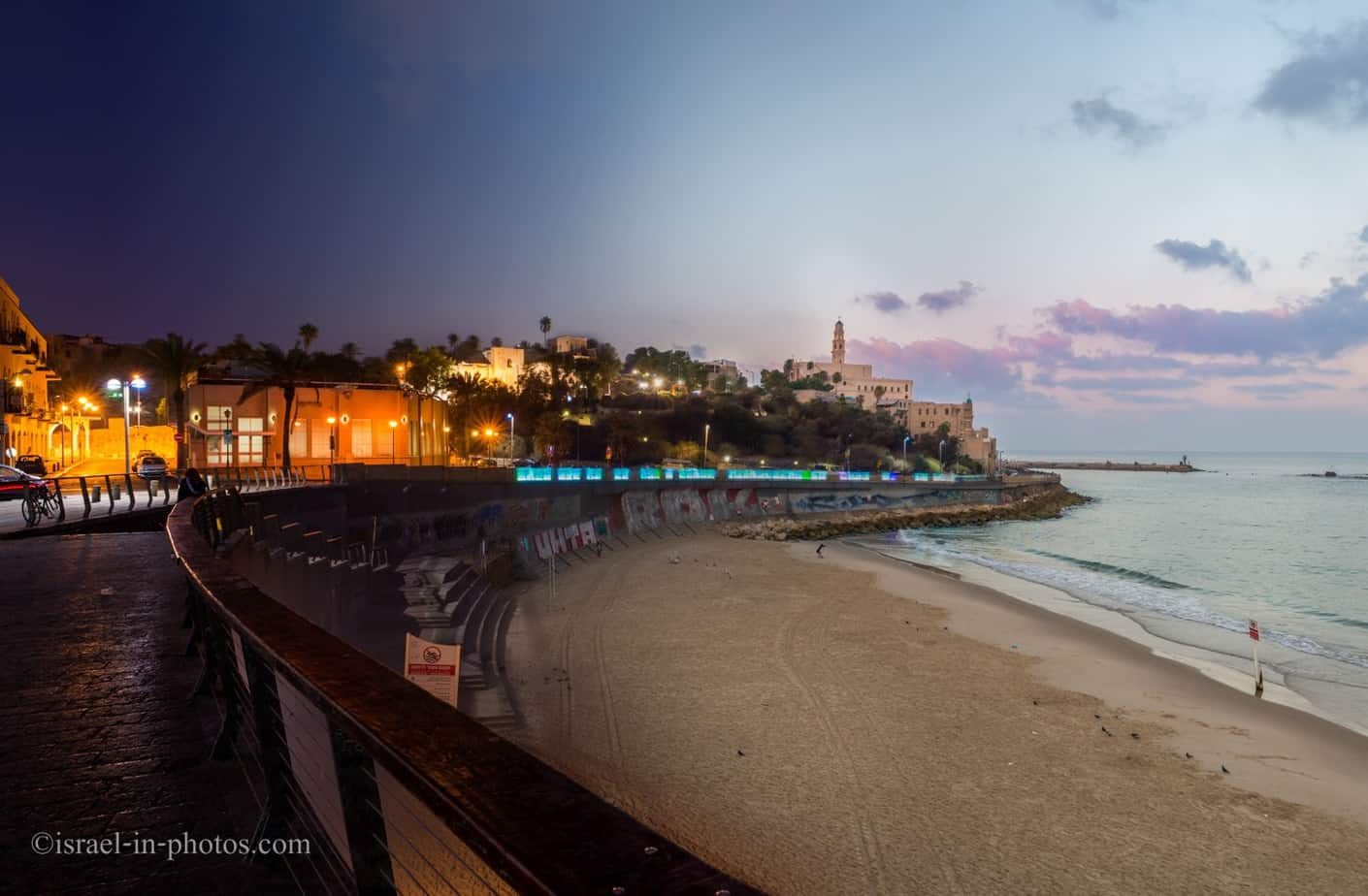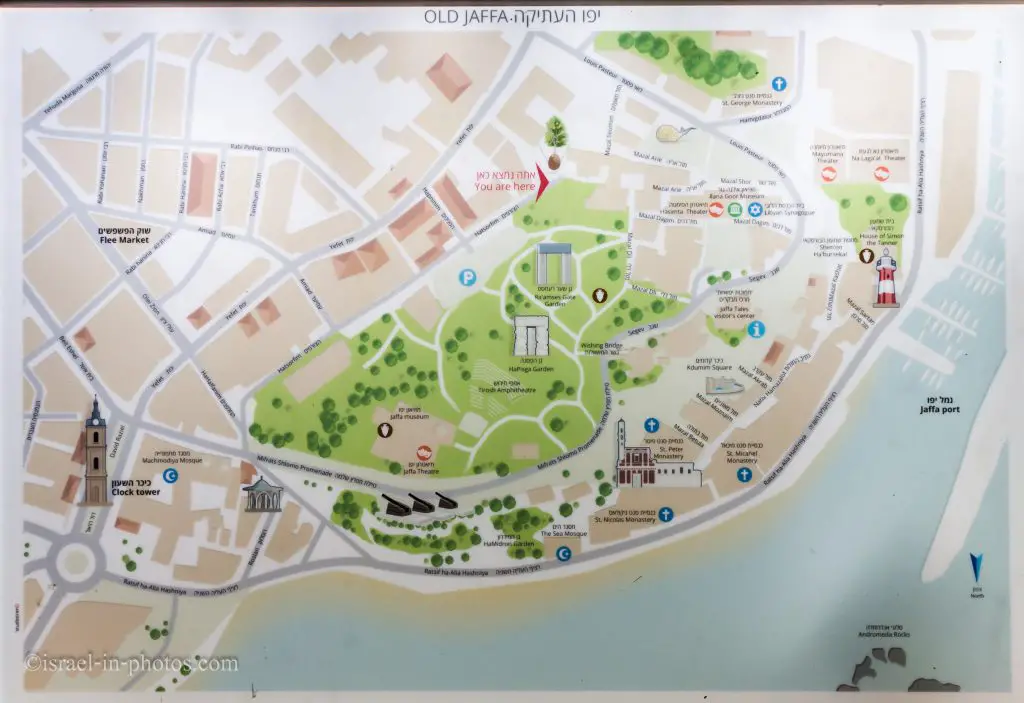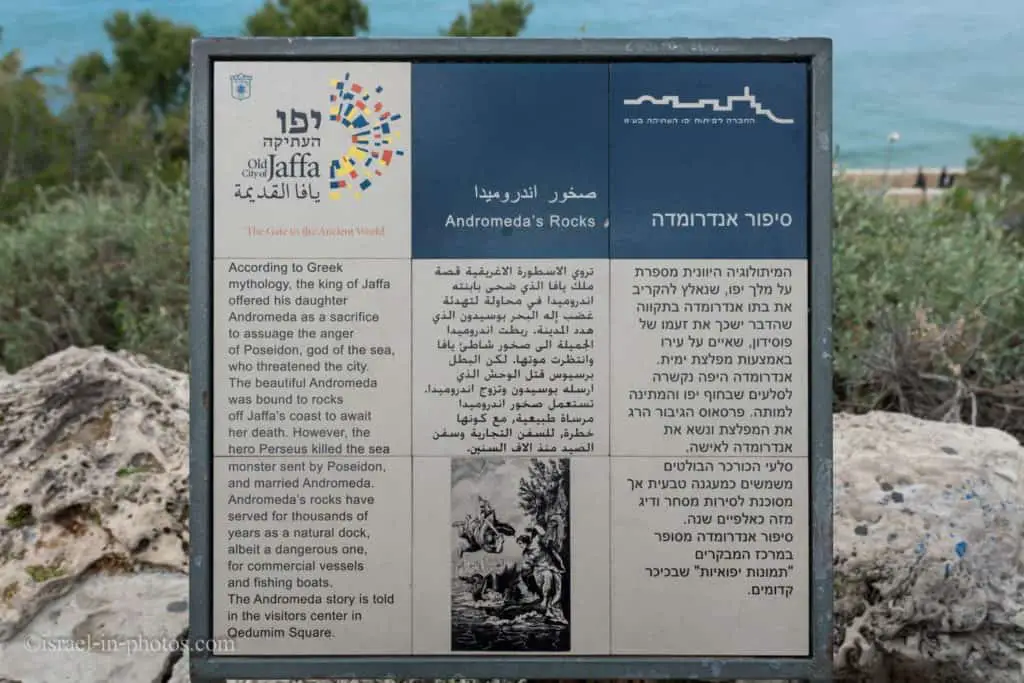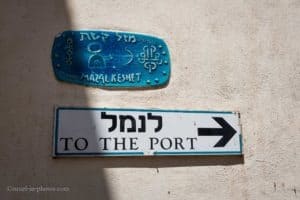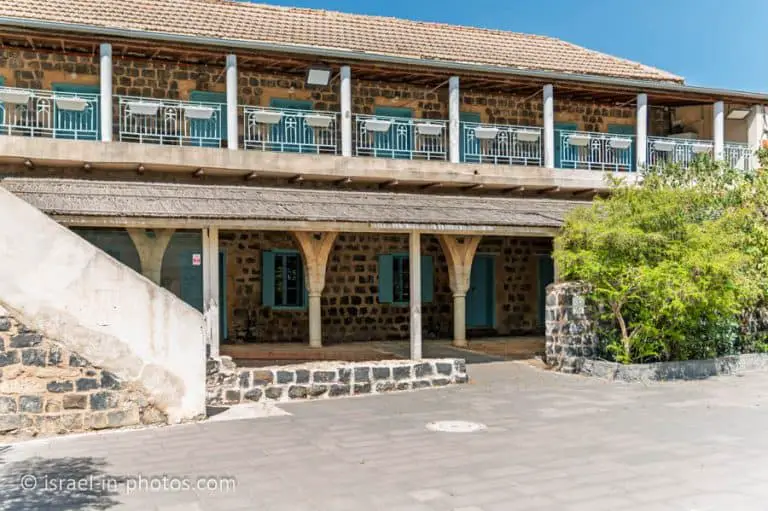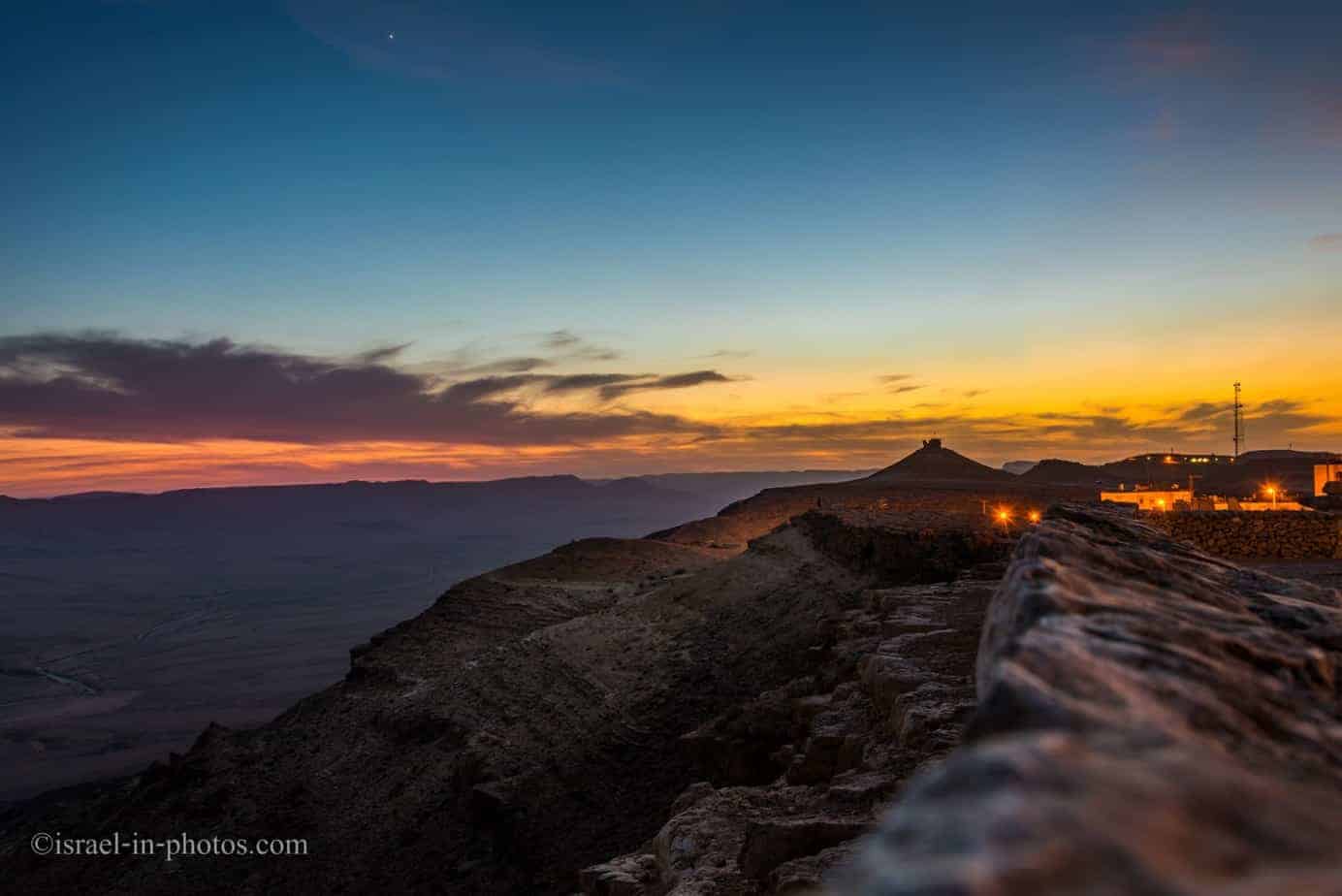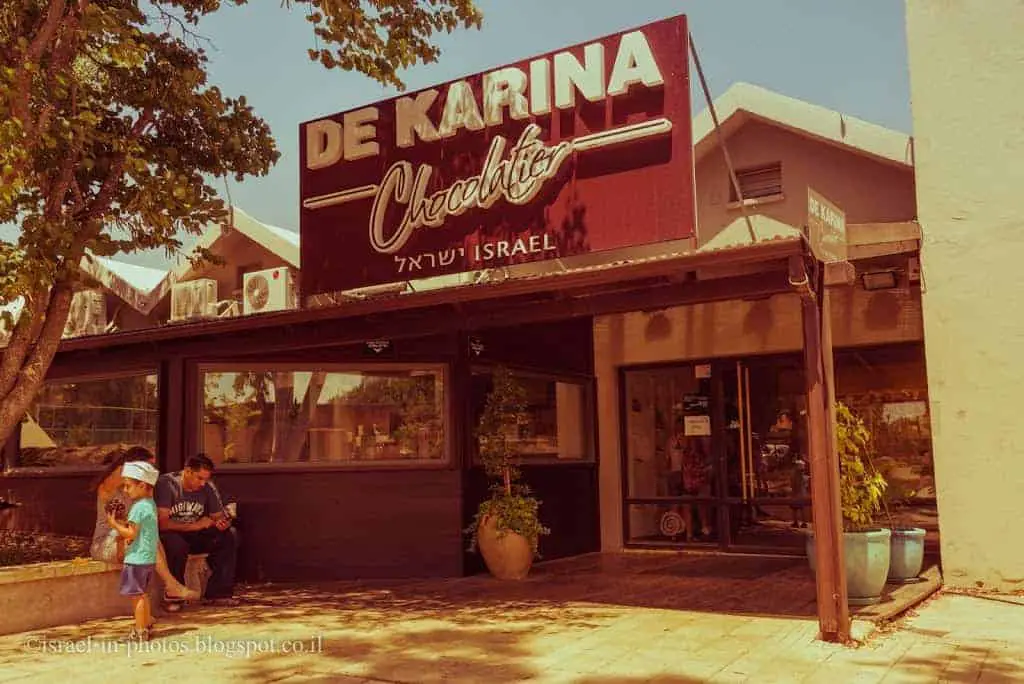Old Jaffa – Full Visitors Guide with Photos
Old Jaffa is one of the oldest port cities in the Mediterranean basin. And by visiting the city’s streets, you can see its rich history.
Notes:
- Today Jaffa is a modern town, and most of its tourist attractions are located within or near the old city. Therefore, in this guide, I will concentrate on Old Jaffa.
- This post focuses on Old Jaffa. If you want to see other places in Jaffa, check out Jaffa Port and Jaffa Flea Market.
- I have visited Old Jaffa many times, and this combined post is the result. Thus, you will see photos taken during different times and seasons.
- The featured Jaffa image belongs to the “From Day To Night” series. In that series, I took and merged several photos of the same scene at different times of the day. To find out more, check out: From Day to Night in Israel.
Table of Contents
- 1 Map
- 2 Parking
- 3 Tours
- 4 What Does Jaffa Mean?
- 5 Jaffa in The Bible
- 6 History
- 7 Mythology
- 8 Tel Jaffa
- 8.1 Sabil Abu Nabut B
- 8.2 Mahmoudiya Mosque
- 8.3 Saint Peter’s Church
- 8.4 Zodiac Fountain
- 8.5 Old Jaffa Visitors Center
- 8.6 Yemenite Art Center
- 8.7 The Wishing Bridge
- 8.8 The Gate of Faith
- 8.9 Ramses Gate
- 8.10 Old Jaffa Alleys
- 8.11 Zodiac Alleys
- 8.12 Ilana Goor Museum
- 8.13 House Of Simon The Tanner
- 8.14 Mysterious Room Of Adina Plastelina
- 9 Jaffa Port
- 10 Food in Jaffa
- 11 The Clock Tower
- 12 Restrooms
- 13 Along Yefet Street
- 14 Common Questions
- 15 Summary
Map
Directions for drivers: Link to Waze and Link to Google Maps
Directions for public transport: Link to Moovit
Interactive map of the area:
And here is the map of attractions in Old Jaffa:
Note: you can click on the map to enlarge it.
Directions
If you visit Tel Aviv, especially the beach, you can probably walk there (from most Tel Aviv beaches, you can see Jaffa). Today Tel-Aviv and Jaffa are under a single municipality. That means you can combine a visit to Jaffa with a walk in one of the nearby Tel-Aviv neighborhoods. For suggestions, check out Tel Aviv-Yafo.
You can also reach Jaffa by public transport. Various buses go through Yerushalayim Avenue, and some even get to the Clock Tower. The bus line number depends on your location. You can use Moovit to find the exact route.
Parking
Finding free parking in this area is a challenging task. But, if you arrive early, you can try Zelda Shne’orson Mishovski Street and Elisabeth Bergner Street (opposite the fuel station). Another better option would be the Jaffa Port parking (Nemal Yafo 24). It is a big free parking lot near the port. When it comes to paid parking, there is a variety of options. And the Old Train Station parking (HaMered Street 65) is the most popular one. It is beneficial if you are planning to visit the Neve Tzedek neighborhood.
Tours
A typical visit to Jaffa will take 2 – 5 hours. If you are short on time, want to make the most of a two-hour visit, or love to learn new things, you can join a tour. Since Jaffa is a popular touristic spot, you can find many different tours. When I searched for free tours (I read somewhere there are such), I stumbled upon SANDEMANs NEW Europe free Jaffa tour. I have not joined one of their tours, so I cannot tell you about my experience. But I saw many positive reviews online. Also, I should mention that these are tips-based tours. Meaning they expect a tip at the end of the tour. Recently I read an article that said the average tip for a free tour in Europe is 10 Euro.
Also, see the Bein Harim offer above.
In any case, it is worth keeping in mind that there is such an option.
What Does Jaffa Mean?
Mythology says that Jaffa is named for Yafet, one of the sons of Noah, the one who built it after the Flood. The Hellenist tradition links the name to Iopeia, or Cassiopeia, the mother of Andromeda. An outcropping of rocks near the harbor is reputed to have been the place where Perseus rescued Andromeda. Pliny the Elder associated the name with Iopa, daughter of Aeolus, the god of the wind. The medieval Arab geographer al-Muqaddasi referred to it as Yaffa.
Source: Wikipedia
Jaffa in The Bible
Jaffa is mentioned four times in the Hebrew Bible. As a city opposite the territory given to the Hebrew Tribe of Dan (Joshua 19:46), as port-of-entry for the cedars of Lebanon for Solomon’s Temple (2 Chronicles 2:16), as the place whence the prophet Jonah embarked for Tarshish (Jonah 1:3) and again as port-of-entry for the cedars of Lebanon for the Second Temple of Jerusalem (Ezra 3:7).
Book of Joshua mentions the city as the territorial border of the Tribe of Dan, hence the modern term “Gush Dan” for the center of the coastal plain. The tribe of Dan did not manage to dislocate the Philistines from Jaffa, but many descendants of Dan lived along the coast and earned their living from ship making and sailing. In the “Song of Deborah,” the prophetess asks: “Why doth Dan dwell in ships?”
After Canaanite and Philistine dominion, King David and his son King Solomon conquered Jaffa and used its port to bring the cedars used in the construction of the First Temple from Tyre.
The city remained in Israelite hands even after the split of the United Kingdom of Israel.
Source: Wikipedia
History
I will not go through history in this section but only mention several vital facts.
Ancient Jaffa was built on a 40 meters high ridge, with a broad view of the coastline, giving it a strategic importance in military history. The Tel of Jaffa, created through the accumulation of debris and landfill over the centuries, made the hill even higher.
Archaeological evidence shows that the site of Jaffa was inhabited around 7500 BCE.
The natural harbor of Jaffa has been in use since the Bronze Age.
The city as such was established at the latest around 1800 BCE.
Source: Wikipedia

As you can see, Jaffa is one of the ancient port cities in Israel and the Mediterranean basin. And by looking at this view of Jaffa, you can see two reasons for this spot becoming a port.
The closeness to the sea is apparent, but Jaffa is on a hill. Most places in this area close to the sea are at sea level. A mountain makes it easier to defend the city. And another reason is water. In ancient times there was a river on the other side of the Tel, which supplied the town with water.
Mythology
The photo above shows a group of rocks to the right. I know it is hard to see, but a flag is on one of the rocks. That is the Andromeda rock. According to Greek mythology, it is the rock to which beautiful Andromeda was chained.
In Greek mythology, Andromeda is the daughter of the Aethiopian king Cepheus and his wife, Cassiopeia. When Cassiopeia’s hubris leads her to boast that Andromeda is more beautiful than the Nereids, Poseidon sends the sea monster Cetus to ravage Andromeda as divine punishment. Andromeda is chained to a rock as a sacrifice to sate the monster but is saved from death by Perseus.
Her name is the Latinized form of the Greek Ἀνδρομέδα (Androméda) or Ἀνδρομέδη (Andromédē): “ruler of men”, from ἀνήρ, ἀνδρός (anēr, andrós) “man”, and medon, “ruler”.
Source: Wikipedia
Tel Jaffa
We will start with a visit to Tel Jaffa. This forty meters high ridge not only allows excellent views, but you can see some of the most popular attractions there.
Note: if you are interested in the meaning of the word Tel (mound), you can find an elaborate explanation at Megiddo National Park.
Sabil Abu Nabut B
Before climbing Tel Jaffa, let’s make a short stop at 13 Russlan Street in Jaffa.
What is a Sebil?
A sebil or sabil is a small kiosk in the Islamic architectural tradition where water is freely dispensed to members of the public by an attendant behind a grilled window. The term is sometimes also used to refer to simple unmanned fountains with a tap for drinking water, though other names often exist for such fountains (such as çesme in Turkish).
Source: Wikipedia
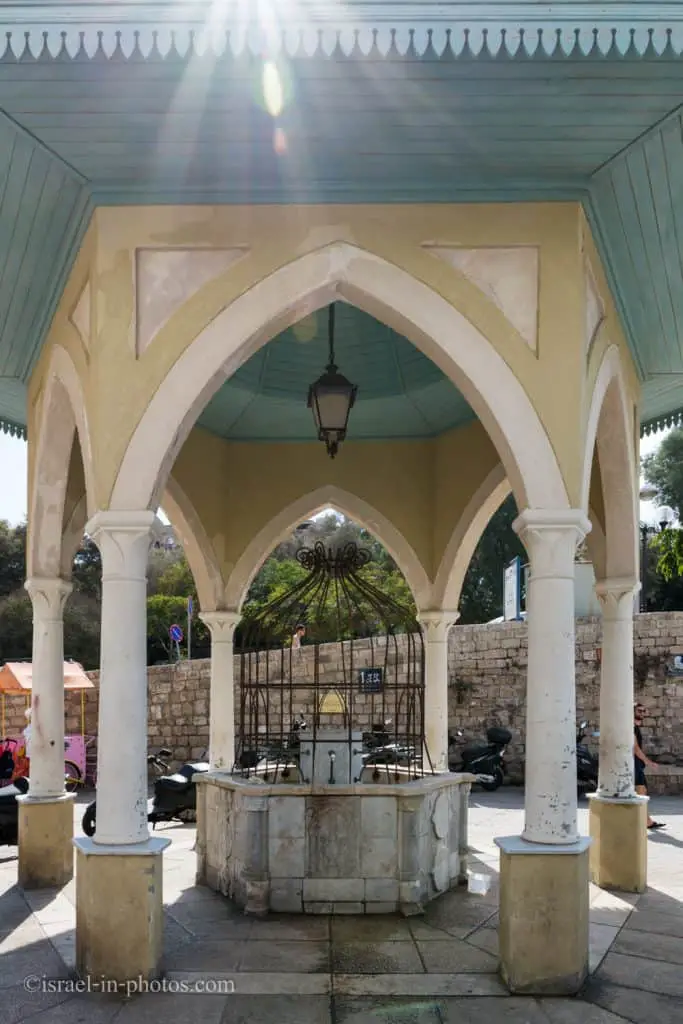
Sabil Abu Nabut B was built in the early 19th century by the Jaffa governor known as Abu Nabut, and it is located near the Mahmoudiya Mosque. There was a magnificent building above the Sabil. But it was destroyed under unclear circumstances. Nonetheless, the Sabil itself survived. And when a new road was constructed, it was moved twenty meters to the west.
In 2011, the restoration and preservation of Sabil Abu Nabut B were started. The recovery was made according to 19th-century paintings, and inside the Sabil, water taps were installed for the general public.
Note: this Sabil is called Abu Nabut B since there is also Sabil Abu Nabbut. Sabil Abu Nabbut, also known as Tabitha’s Well, is located on Zvi Herman Segal Street in Tel Aviv, near the Russian Orthodox Church In Abu Kabir. It was built in 1820/21 CE during the Ottoman period, and its primary purpose was to facilitate the journey between Jaffa and Jerusalem.
Mahmoudiya Mosque
On 7 Ruslan Street, near Sabil Abu Nabut B, you can find the entrance to Mahmoudiya Mosque. The mosque was built during the 19 century by Muhammad Aga a-Shami (nicknamed Abu Nabut), governor of Jaffa, on behalf of the Ottomans.
On the southern exterior wall of the Mahmoudia Mosque on Tayelet Mifraz Shlomo Street, you can find another Sabil. It is named Sabil Suleiman after Suleiman Pasha, the Acre ruler who appointed Abu Nabout as governor. The Sabil was built in the form of a large arch that combines white marble stones and pink granite. This Sabil was outside the city and served people who entered the city gate.
And now, let’s climb Old Jaffa along Tayelet Mifraz Shlomo Street.

After climbing almost to the top of the hill, you find several viewpoints. This one presents several cannons and the Tel Aviv coastline.
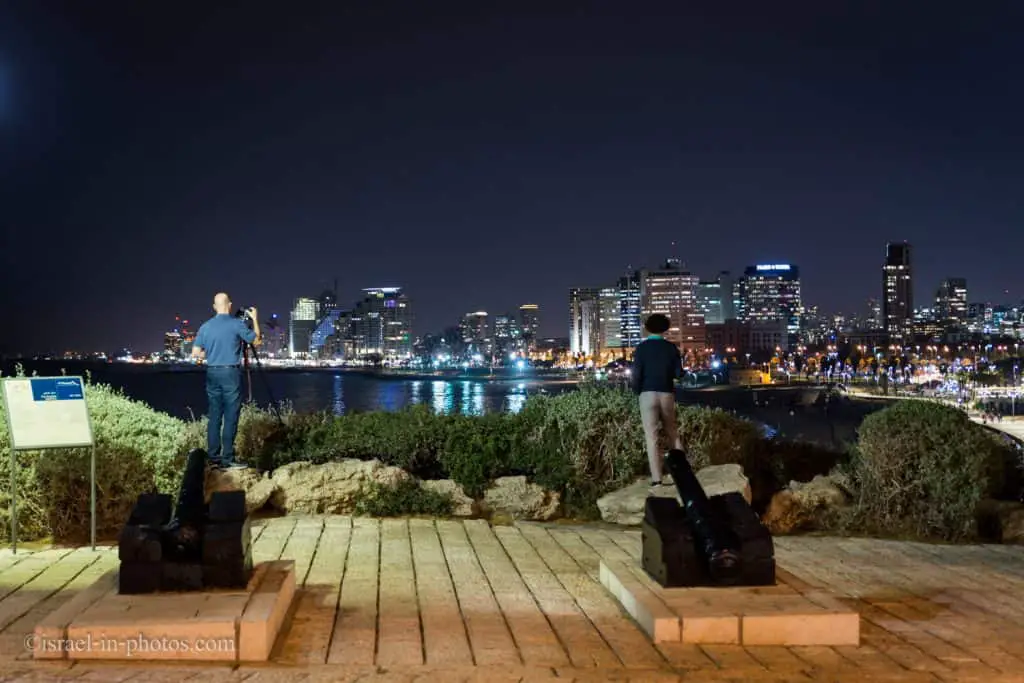
There are additional cannons around old Jaffa, and they serve as a reminder of the time Napoleon conquered the city.
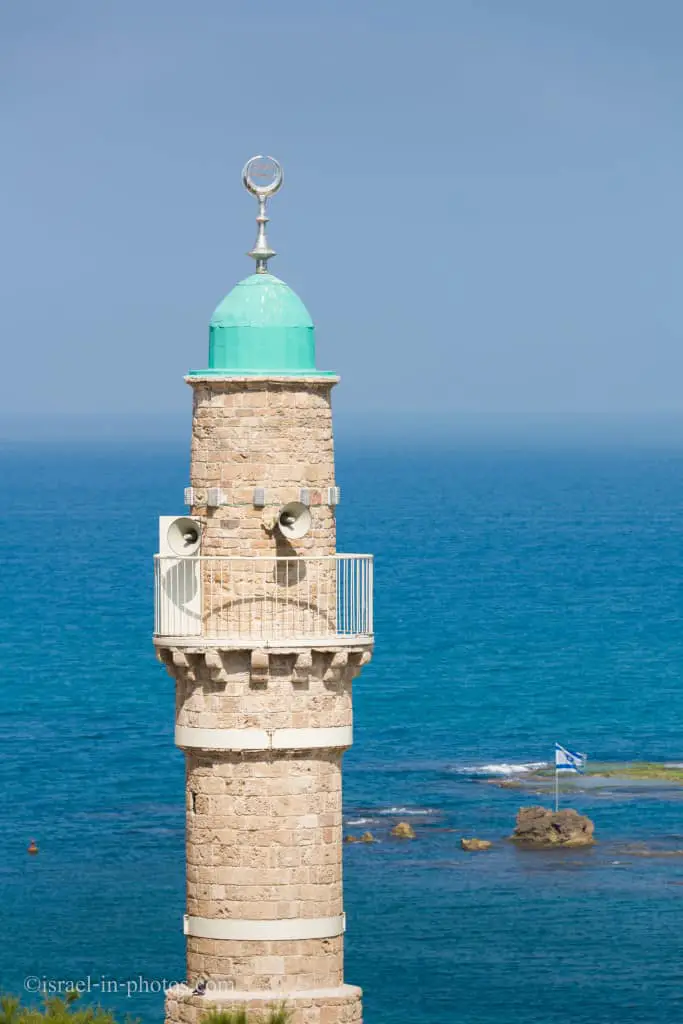
And after a short walk, we reached Saint Peter’s Church.
Saint Peter’s Church
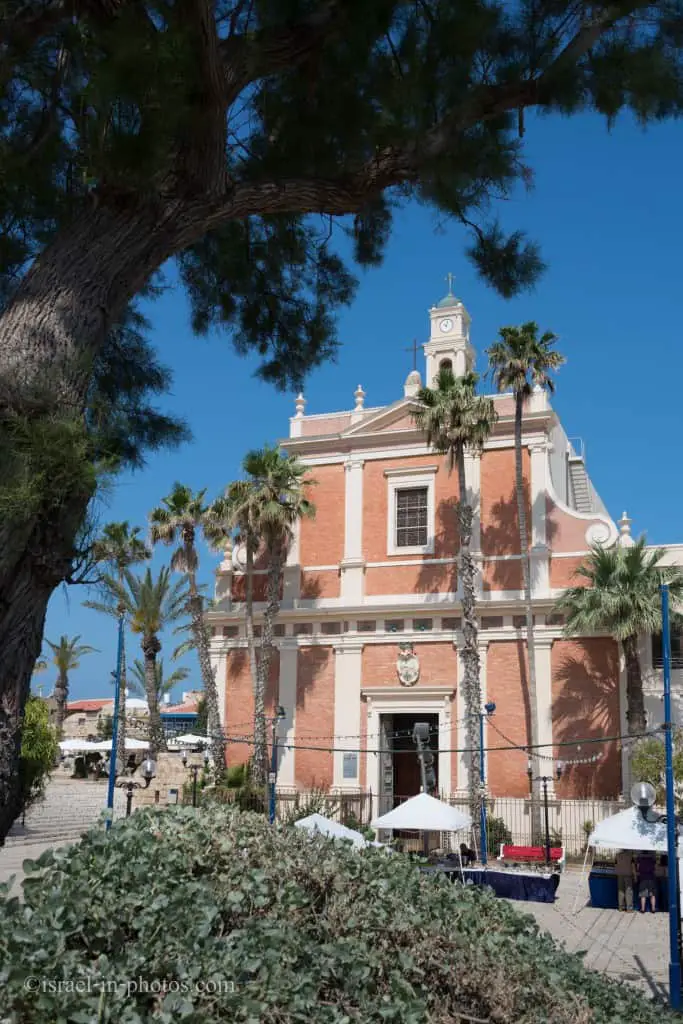
There is usually a small market in front of Saint Peter’s Church. In those stands, you can find primarily souvenirs and handmade jewelry.
Saint Peter’s Church sits at the top of the Jaffa Mound, at a strategic spot, and has served as a Christian center for thousands of years. Underneath the church and to its side are the remnants of a crusader fort, underneath which a Byzantine church is buried. The fort was part of the city citadel during the reign of Louis IX, king of France. In the church’s courtyard stands the statue of Louis IX, who was canonized in Christian tradition for his part in the crusades.
According to accepted history, the church also hosted the French general Napoleon when he stayed in Jaffa during his campaign in Israel in 1799.
The church is vast and is noted for its splendor. It was constructed at the beginning of the 20th century in the Baroque style, with a long nave and a vaulted ceiling. As opposed to most churches which face east, Saint Peter’s faces west, towards the sea, where Peter’s famous dream took place, and towards Rome, where he was sent later.
The walls of the church are decorated with oil paintings depicting the Fourteen Stations of the Cross and Saint George fighting the dragon. Over the altar is a depiction of Peter’s visitation in a dream by the angel Michael.
Note: unless stated otherwise, all quotes were taken from the Official Site.
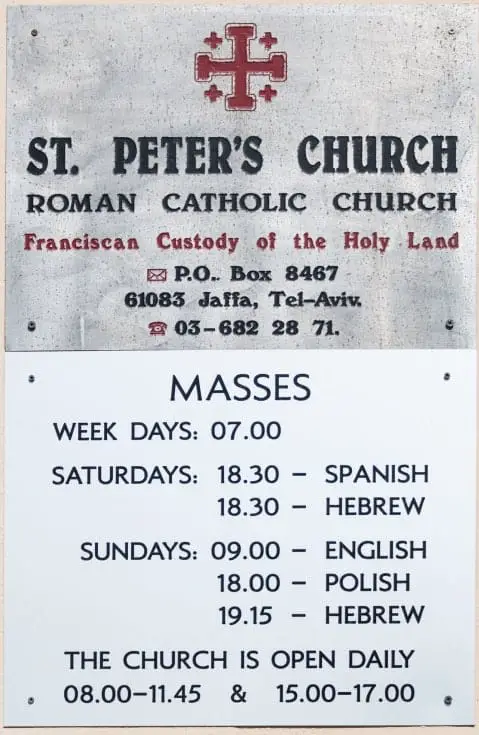
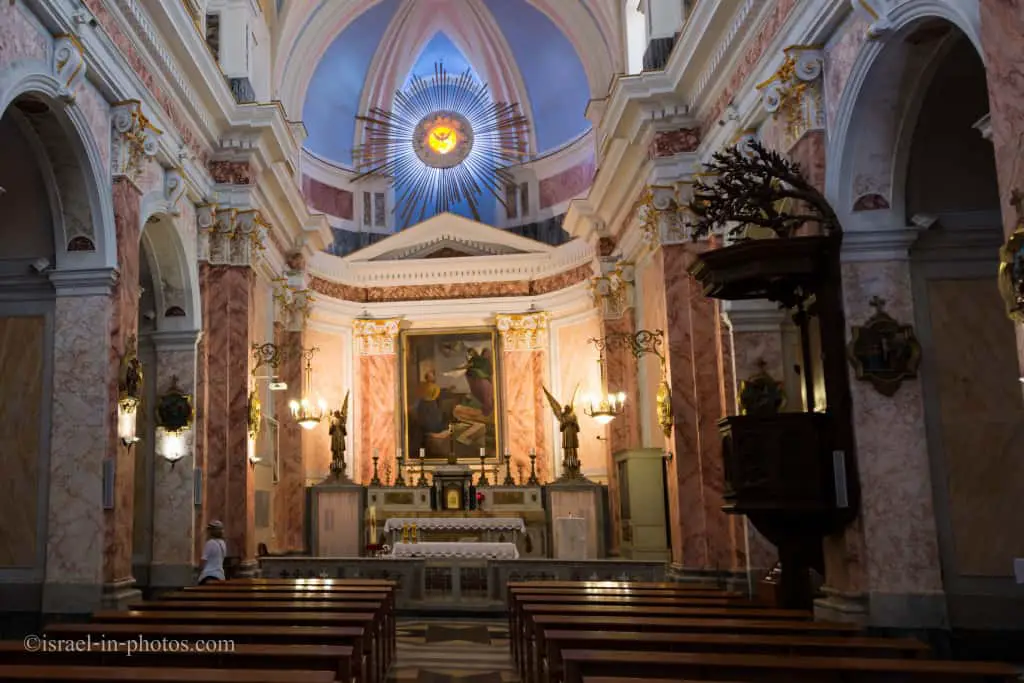
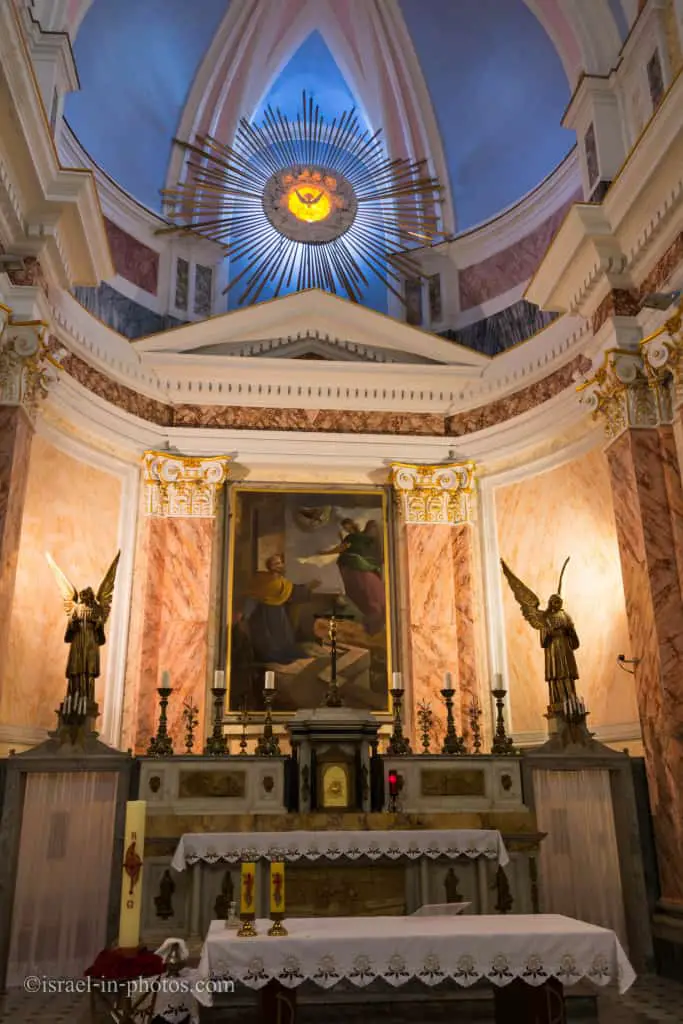
If you want to send a letter to the Vatican, you can go around the church and find a Vatican post box.
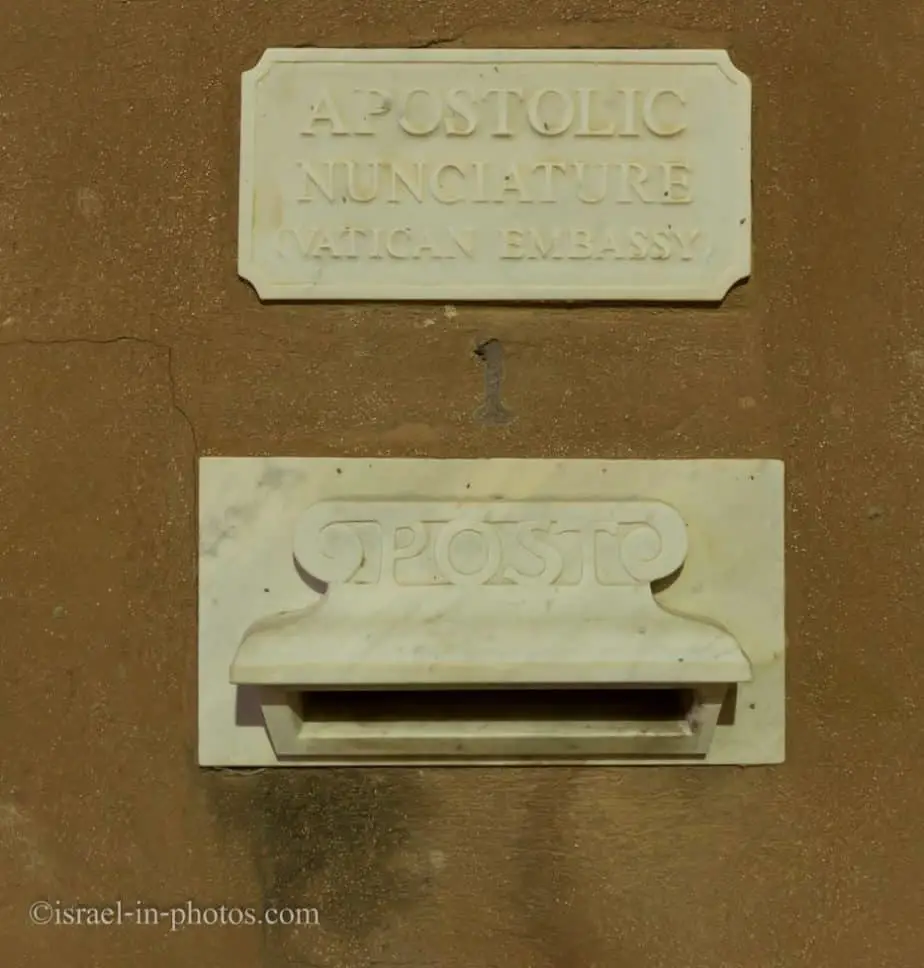
And this is how Saint Peter’s Church looks at sunset:
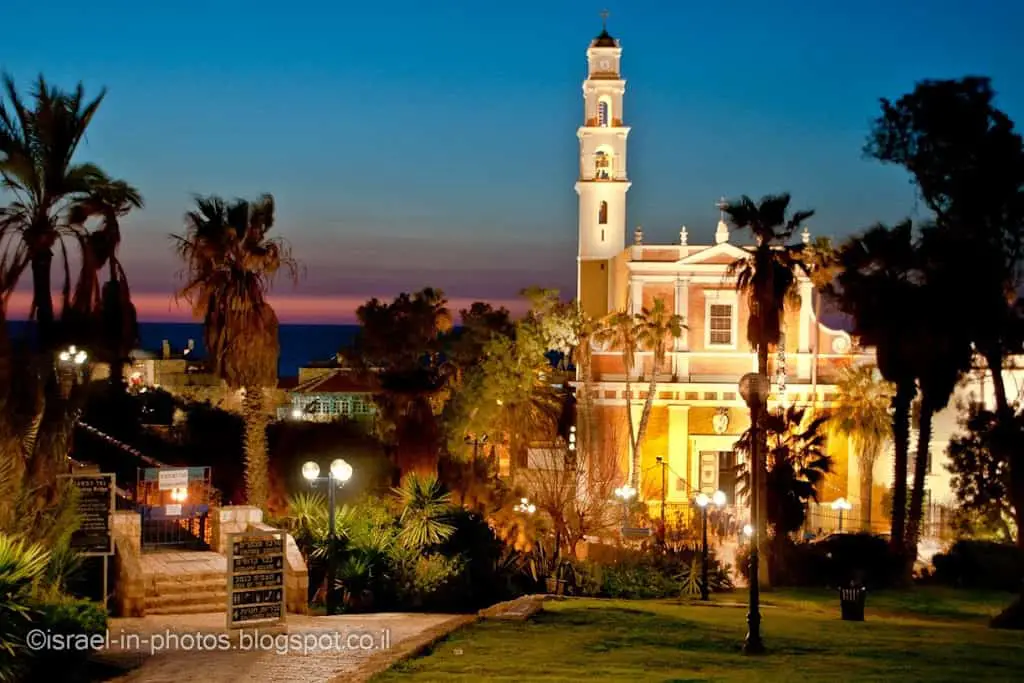
I made this shot from the nearby Hapisga Garden. But we will reach it later. Meanwhile, let’s visit the nearby Zodiac Fountain.
Zodiac Fountain
You can find the Zodiac Fountain about twenty meters south of Saint Peter’s Church.
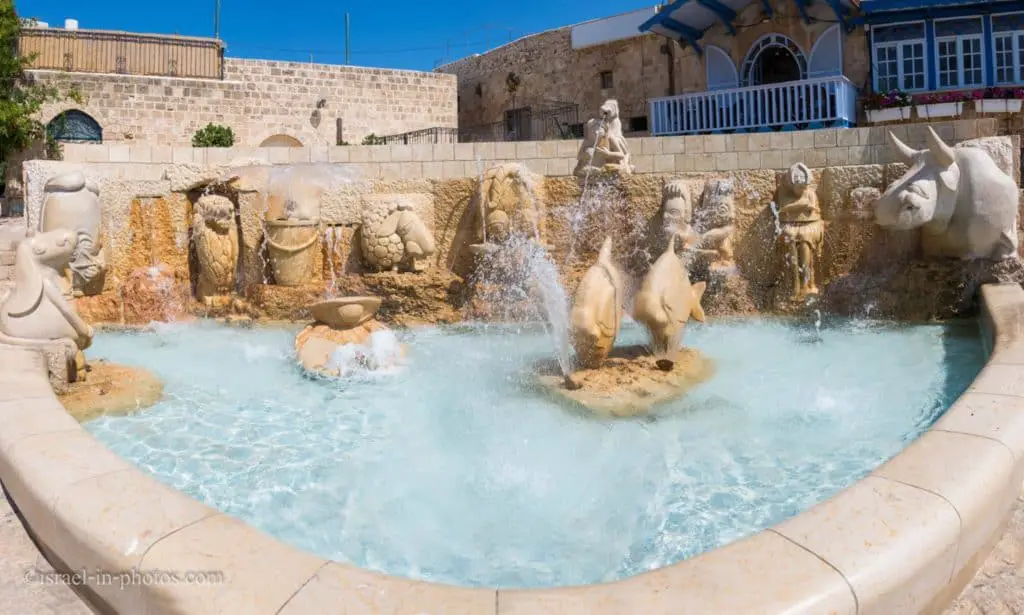
The Zodiac Fountain was made by the sculptors Varda Ghivoly and Ilan Gelber in 2011. The fountain, located in Kdumim Square, bears chalkstone sculptures of the twelve zodiacs in interesting, original designs.
The fountain combines effects of water, lighting, and stonework and completes the representation of the twelve zodiacs in Old Jaffa. The constellations also appear in the street names of Old Jaffa and the Wishing Bridge connecting Jaffa Hill with Kdumim Square.
As part of the fountain’s digging work, the Antiquities Authority conducted a salvage excavation at the site. The dig was managed by Mr. Diego Barkan of the Antiquities Authority. The digging exposed the Ottoman period’s architectural elements, including remnants of structures, walls, and floors, and a tiled yard containing a water reservoir, and constructed roofed aqueducts.
The findings found under the fountain corroborate an old legend mentioning the existence of a magical wishing well located in this very place. Anyone who tosses a coin in it and makes a wish has the wish fulfilled on the spot.
While in old Jaffa, you may notice that many windows are painted blue. It is an old custom where people believed that blue brings good luck.
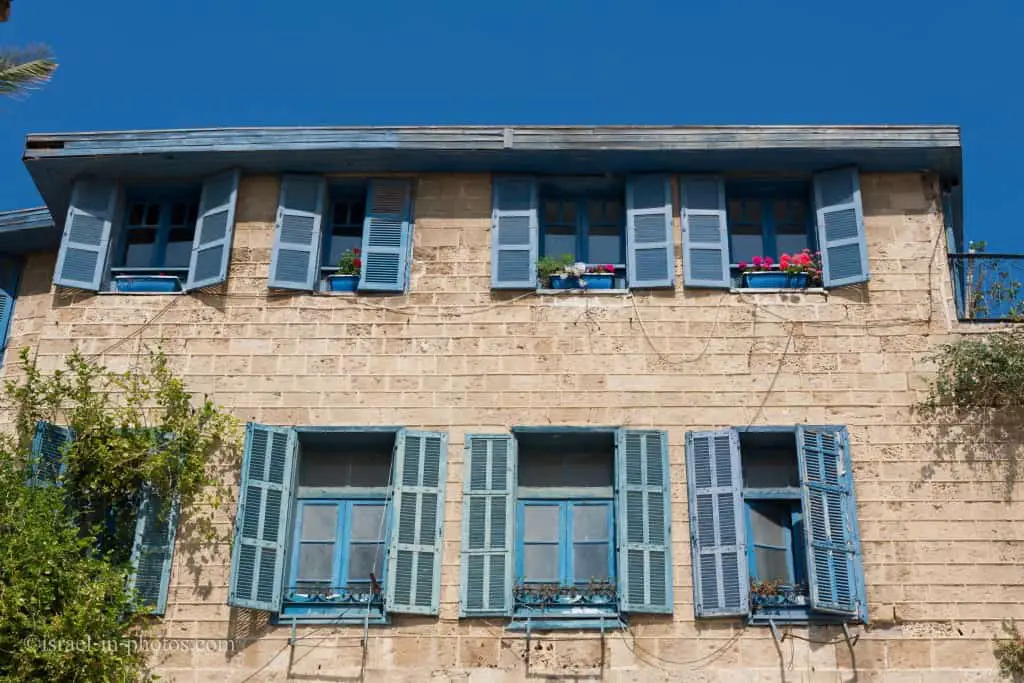
Old Jaffa Visitors Center
The Zodiac fountain is located at Kdumim Square. And under the square, you can find the visitor’s center.
Experience 5000 years of history in one of the most ancient port cities in the world. Observe the major archeological discoveries found in Jaffa, meet the central characters in the tales of Jaffa, and learn the city’s history.
Opening hours
Summer (March-November)
Sunday-Thursday & Saturday 9:00-20:00
Friday 9:00-17:00Winter (December-February)
Sunday-Thursday & Saturday 9:00-17:00
Friday 9:00-15:00One can coordinate group visits during other hours as well. Entry is by advance invitation or on the basis of available space. It is advisable to reserve a place by telephone: 03-603-7700, 03-603-7686 or by e-mail: tourism@oldjaffa.co.il
Yemenite Art Center
On the far end of Kdumim Square, you can find a small Yemenite Art Center.


They have a small display showing Yemenite art and how it was created:
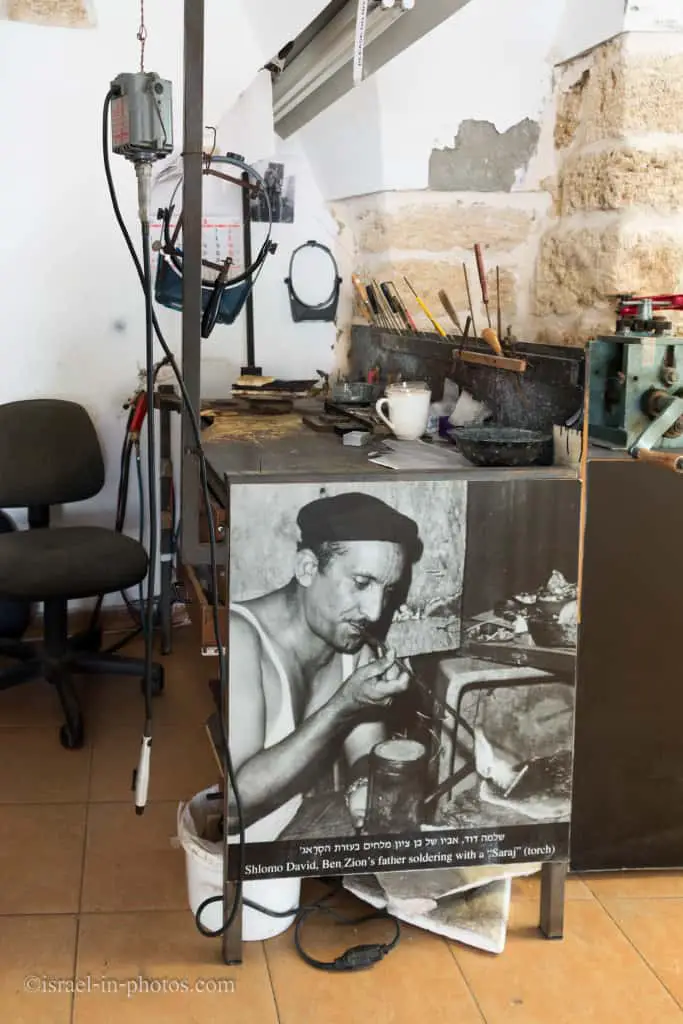
And, of course, they have a store where they sell their handmade jewelry.
And since we are on the topic of art, there are many art galleries and jewelry stores in old Jaffa’s alleys. If you are looking for a souvenir, a present, or love to mingle in galleries, I recommend the Zodiac alleys in the old Jaffa (we will reach them later in this article).
The Wishing Bridge
Next, we headed to The Wishing Bridge. It is located close to Saint Peter’s Church. And at one of the entrances to The Wishing Bridge, you can find this stone mosaic.
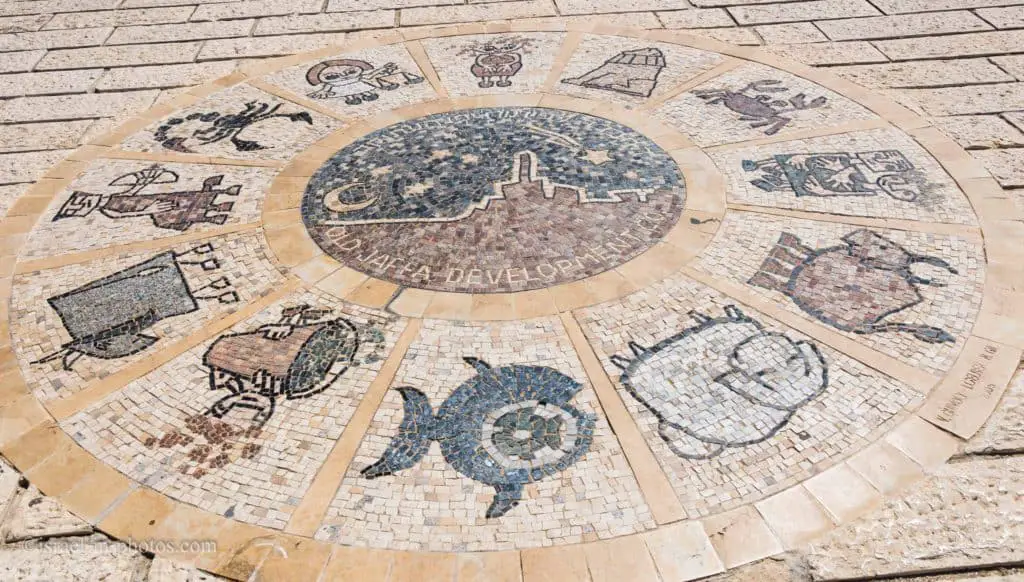
While initially writing this post, the Wishing Bridge was closed for reconstruction. But it is already open to the public.
An ancient legend states that anyone who stands on the bridge grasps the relief of their astrological sign and gazes at sea –will have his wish come true!
Stationed on top of the rail of the famous wooden bridge connecting Peak Park with Kdumim Square are bronze statues of the twelve astrological signs. At the entrance to the bridge is a stone mosaic of the zodiac.
Esther Shlomo and Freddy Fabian sculpted the statues along the bridge, and the mosaic was created by Varda Ghivoly, Ilan Gelber, and Navot Gil, all residents of Old Jaffa.
The Gate of Faith
You can find The Gate of Faith at the highest point of Tel Jaffa, at Hapisga Garden.

A large statue, made of Galilee stone, was sculpted by the sculptor Daniel Kafri of Jerusalem between the years 1973-1975. The statue stands at the top of Peak Park in Old Jaffa.
The statue, of two 4 meter tall pillars upon which rests a stone, also 4 meters in length, resembles a gate. The sculpted entrance is the gate of entry to the Land of Israel and represents the promise of the land to the Patriarchs – Abraham, Isaac, and Jacob.
On the two pillars appear the three Patriarchs – who received the promise – and the top stone signifies the beginning of that promise’s realization via the capture of Jericho and the Land of Israel by Joshua.
The first pillar recounts the tale of the binding of Isaac. That is an extraordinary portrayal of the binding – Abraham is seen kneeling on the ram, and holding up his son Isaac. Isaac lies with his face, resembling Abraham’s, turned upward.The second pillar depicts Jacob’s dream, where the land was promised to his offspring. Jacob rests on the ground, and the stone is under his head. Above him are two angels, one ascending and one descending, facing opposite directions, and the rhythm of the wings creates an association with a ladder.
The top beam represents the realization and depicts the capture of Jericho. The priests surround the city of Jericho, holding horns and are seen carrying the Ark of the Covenant.
Ramses Gate
And as we go down, we visit the Ramses Gate (with Saint Peter’s Church in the background).
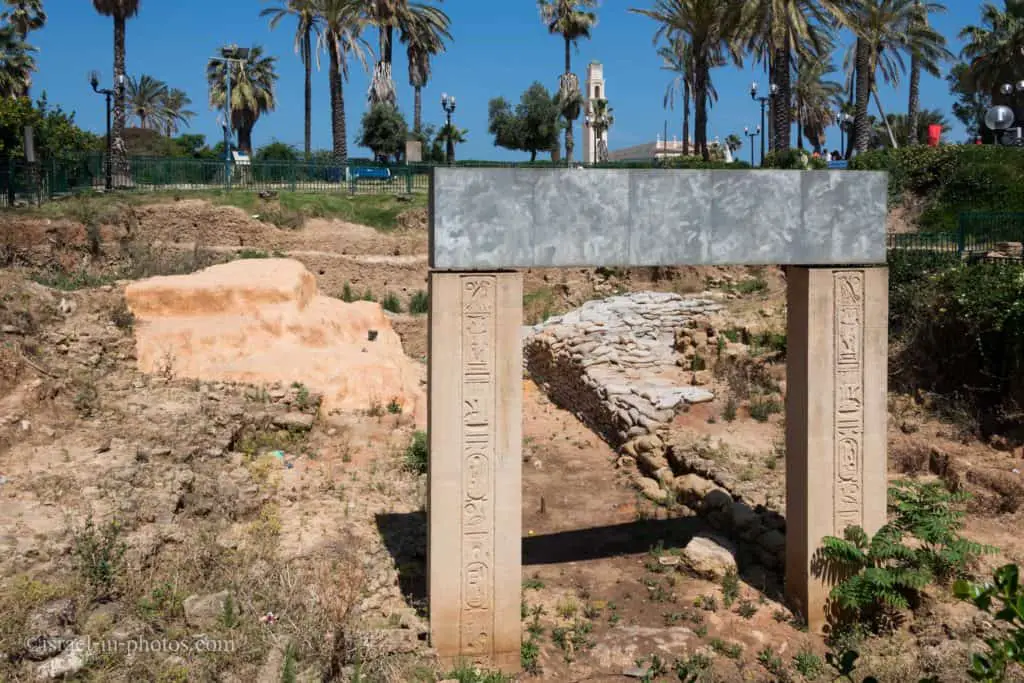
The most ancient remnants that were discovered in Jaffa are the remnants of a glacis that surrounded the hill during the 18th century B.C.E. (the Second Middle Bronze Age). The remnants from this period, the period of the Egyptian conquest, attest that Jaffa was a city under Egyptian control on the model of other cities in Canaan.
In the central excavation area currently located in the Ramses Gate Garden remnants of a community from the close of the 17th century and the first half of the 16th century B.C.E. were discovered.
From the Late Bronze Age (the latter half of the 16th century and the 15 century B.C.E.), the remnants of buildings built out of bricks on stone foundations were discovered.
From the Late Bronze Age (13-1400 BCE), three layers of the settlement were discovered: In the lowest layer, the remnants of structures and a granary built out of unhewn stones were discovered. Above it, we find the remains of an entrance gate to a luxurious palace from the period of the Egyptian Pharaoh Ramses II (1237-1304 B.C.E.). The artwork of the gate was built out of hard and chiseled sandstone in which hieroglyphics bearing the titles and portions of the name of Ramses II are engraved. The walls were built out of bricks. And on top of them are remnants of the gate (the bronze axle of a wooden gate has been found) and the Egyptian fort that was destroyed in a vast conflagration (the end of the 13thCentury and beginning of the 12th Century B.C.E.)
And in this context, it is worth mentioning
How Old is Jaffa?
Some externally written testimonies referring to Jaffa have survived from this era, and they are:
The Harris papyrus describes the conquest of Jaffa by stealth by the Army of the Pharaoh Thutmose III (1450-1504 B.C.E.) by providing a gift in the form of large jugs in which Egyptian soldiers were hidden to governor Jaffa, which enabled the city’s conquest from within.
The city appears in a list of towns conquered by Thutmose III at the Temple of Karnak in Egypt.
Remnants of official letters engraved in cuneiform on mud tablets were discovered in the Pharaonic Archives at Tel el-Amarna in Egypt where the granaries of the Pharaoh in Jaffa were mentioned. At Tel Afek (near Rosh Ha’Ayin) a similar letter where Jaffa is mentioned was discovered.
The Papyrus Anastasi describes an expedition by a courtier in Canaan and includes a description of Jaffa, its gardens, and residents at the close of the 13th century B.C.E.
Old Jaffa Alleys
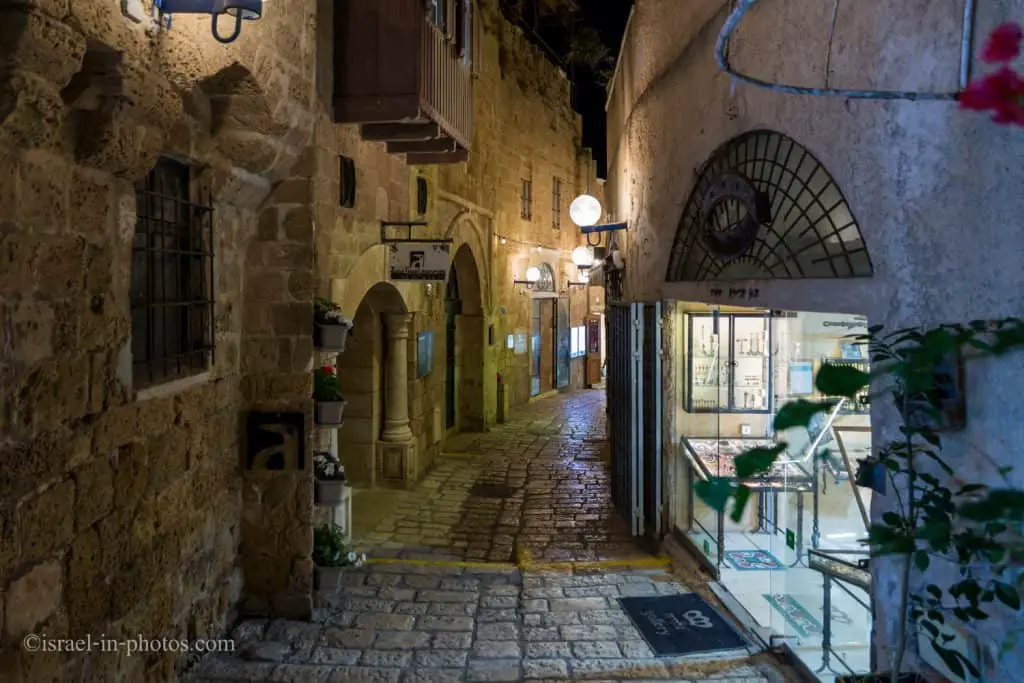
Jaffa Oranges
As we approach the Floating Orange Tree in one of the alleys, I want to mention Jaffa Oranges. This orange type was among the top export products for many years.
The Jaffa orange (also known as Shamouti orange) is an orange variety with few seeds and a tough skin that makes it particularly suitable for export. Developed by Ottoman farmers in the mid-19th century, the variety takes its name from the city of Jaffa where it was first produced for export. The orange was the primary citrus export of the town. It is, along with the navel and bitter orange, one of three main varieties of the fruit grown in the Mediterranean, Southern Europe, and the Middle East. The Jaffa is also cultivated in Cyprus, Iraq, Lebanon, Syria, Jordan, and Turkey.
Production of Jaffa oranges is much lower today than in the past; historically they were considered the most famous export in the early state of Israel.
Source: Wikipedia
Are Jaffa Oranges From Israel?
Today, Jaffa Oranges is a trademark leased to several countries in Southern America and several European countries (here is an article about Jaffa oranges in Spain). Thus, if you buy oranges with the “Jaffa” sticker, this does not necessarily mean that they were grown in Israel.
Jaffa Cakes
Since we discussed Jaffa oranges, I want to mention Jaffa cakes (usually have an orange flavor). Jaffa Cakes are named after Jaffa oranges, and though they did not gain popularity in Israel, they are one of the best-selling cakes in the UK.
Jaffa Cakes are biscuit-sized cakes introduced by McVitie and Price in the UK in 1927 and named after Jaffa oranges. The most common form of Jaffa cakes is circular, 2 1⁄8 inches (54 mm) in diameter and has three layers: a Genoise sponge base, a layer of orange-flavored jam, and a coating of chocolate. Jaffa cakes are also available as bars or in small packs, and in larger and smaller sizes. The original Jaffa Cakes come in packs of 12, 24, 36, or 48.
Because McVitie’s did not trademark the name “Jaffa Cakes,” other biscuit manufacturers and supermarkets have made similar products under the same name. The product’s classification as a cake or biscuit was part of a VAT tribunal in 1991, with the court finding in McVitie’s favor that the Jaffa cake should be considered a cake for tax purposes. In 2012 they were ranked the best-selling cake or biscuit in the United Kingdom.
Source: Wikipedia
Floating Orange Tree
From the Ramses Gate, we continue to the old Jaffa alleys. On our way, we passed near the hanging tree, also known as the Floating Orange Tree:
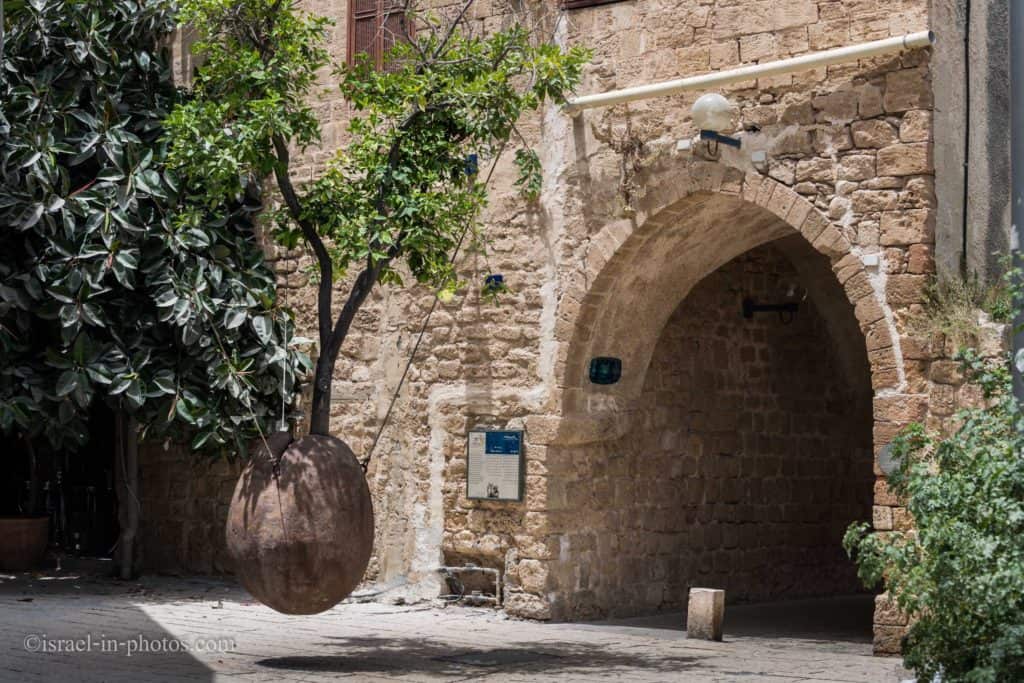
Among the city streets of old Jaffa is a hidden work of Morin’s known as the Floating Orange Tree. Finished in 1993, this is a small orange tree that is elevated off of the ground by a large earthenware jug hung by metal chains from the walls of houses nearby. The tree is growing out of the pitcher, trying to break it. Morin sought to emphasize the developing world of separation between man and nature, as “creatures that grow in containers.”
This statue is hung only a foot or so off of the ground – enough to see its shadow, but not so high that it seems about to fall down.
Source: Wikipedia
Zodiac Alleys
The names of the lanes are the same as those of the zodiac signs. And this is mine.
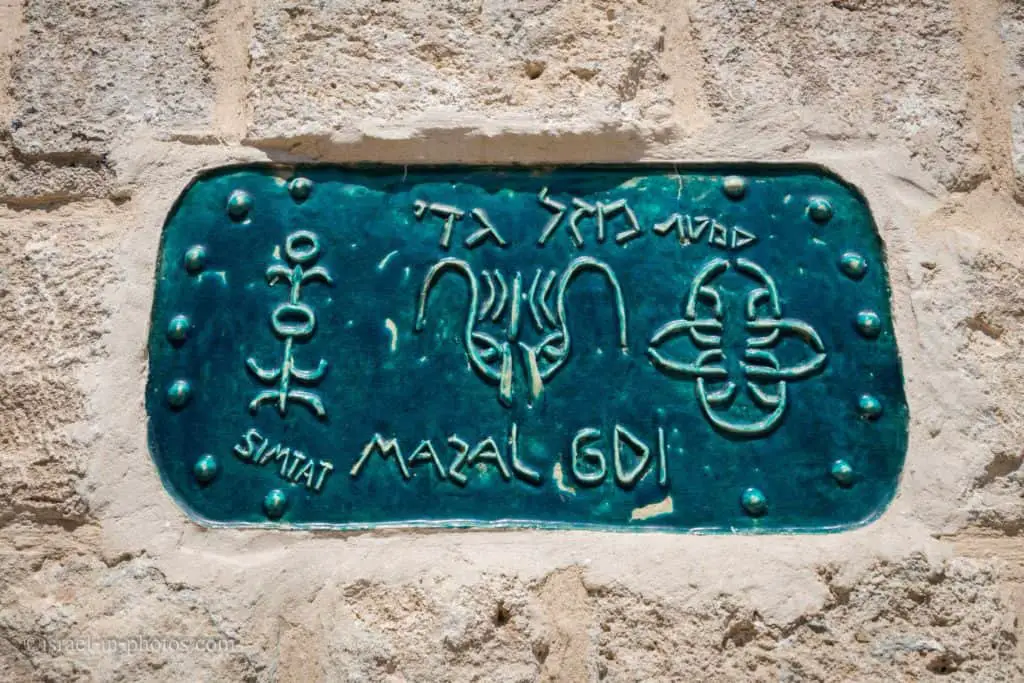
And here is one with a number:

And some smaller labels only have a number and a drawing of the zodiac sign:

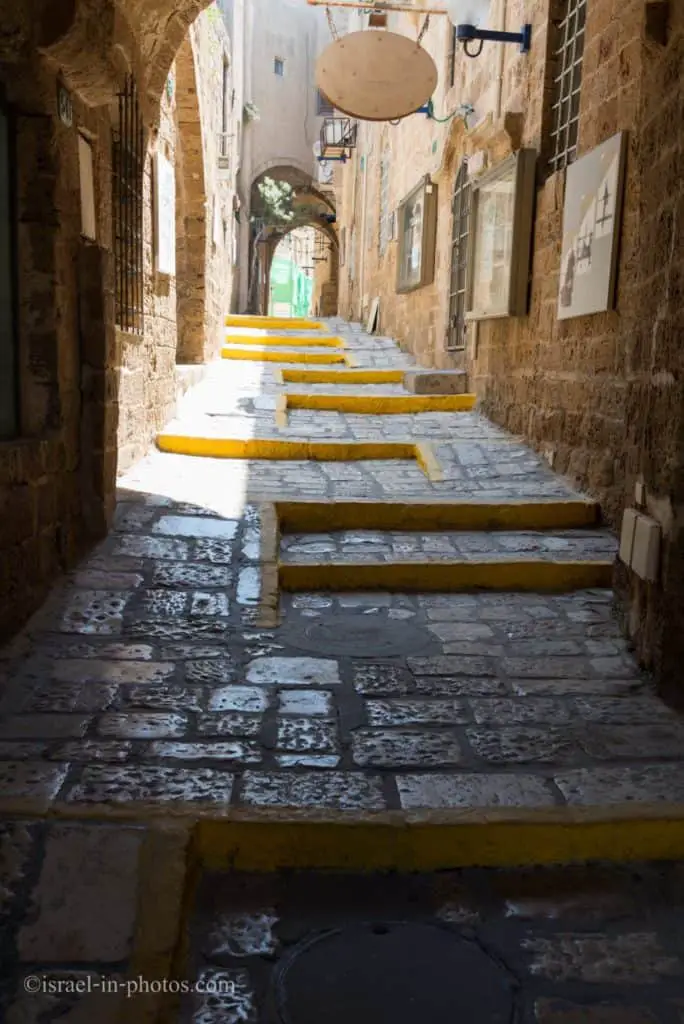
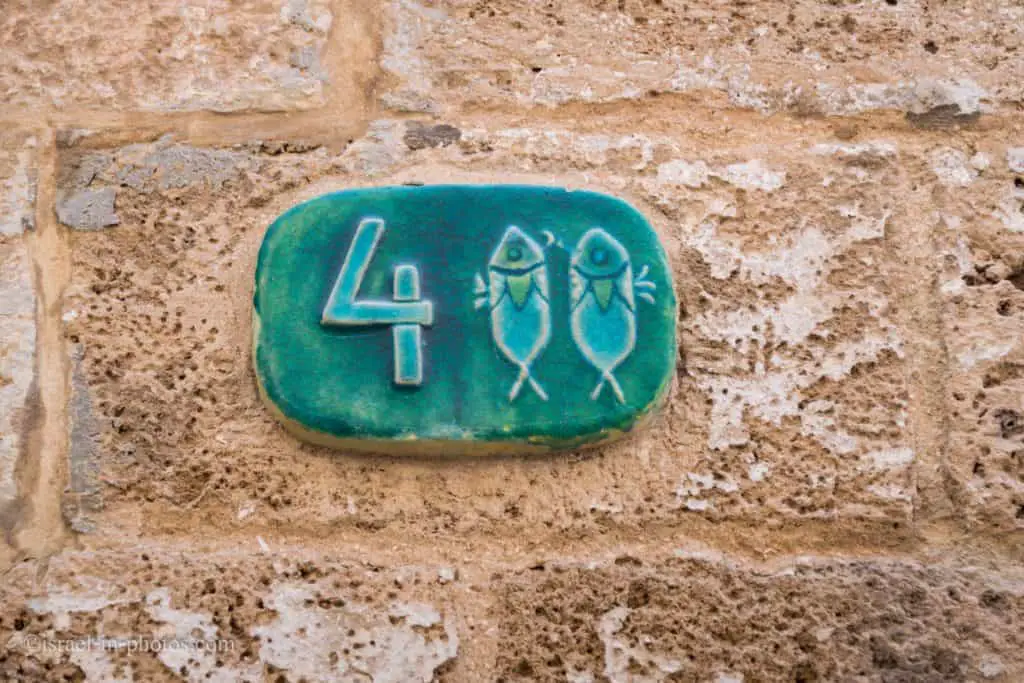
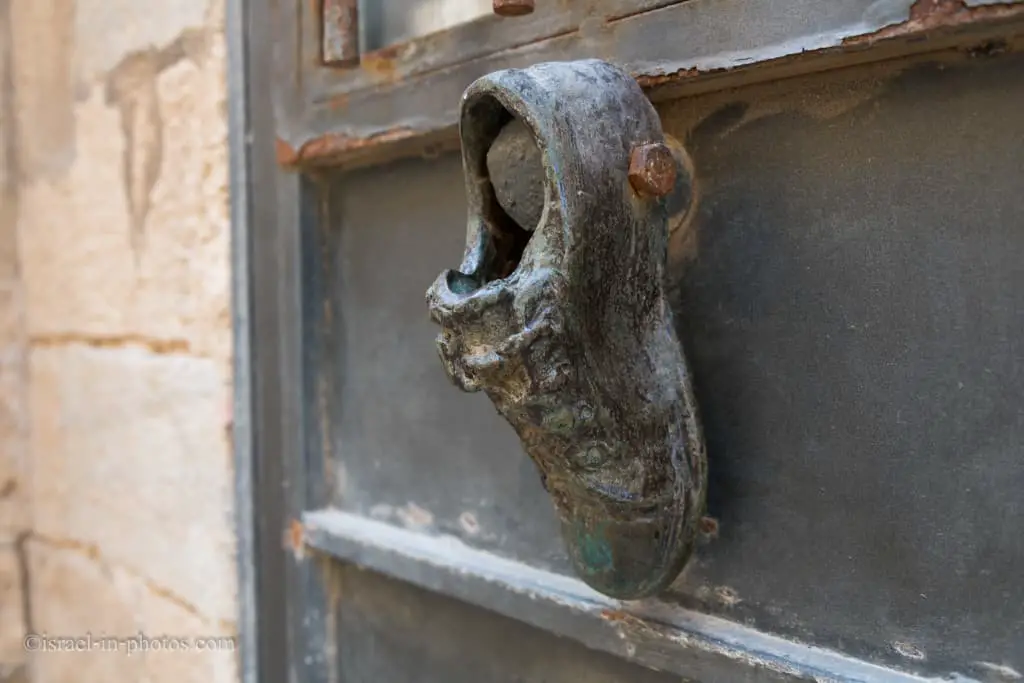
Ilana Goor Museum
You will reach The Ilana Goor Museum as you pass through old Jaffa (to the south). Nearby, you can find this sculpture of a whale by Ilana Goor. The bible story of Jonah and the whale inspired the Smiling Whale sculpture.

Ilana Goor is an individualistic, autodidactic, intuitive and multifaceted artist. As an artist who knows no boundaries and whose art transcends any conventions, her creations are a blend of vitality and obsession, functional simplicity alongside emotional complexity bordering on surrealism. Her sources of inspiration are neither time nor place-dependent. They create a personal statement, a journey replete with meaning, and they succeed in touching and moving people the world over.
The Museum building stands on a hill in Old Jaffa and constitutes an architectural pearl and a work of art in itself with its unique view of the Mediterranean Sea.
Source: Ilana Goor Museum
House Of Simon The Tanner
After wandering at Tel Jaffa, we will descend toward sea level. There are several ways down, and I will take you through the small alleys. You can find stairs down toward Jaffa Port near Saint Peter’s church.
You can find the House Of Simon The Tanner in one of the valleys leading down.
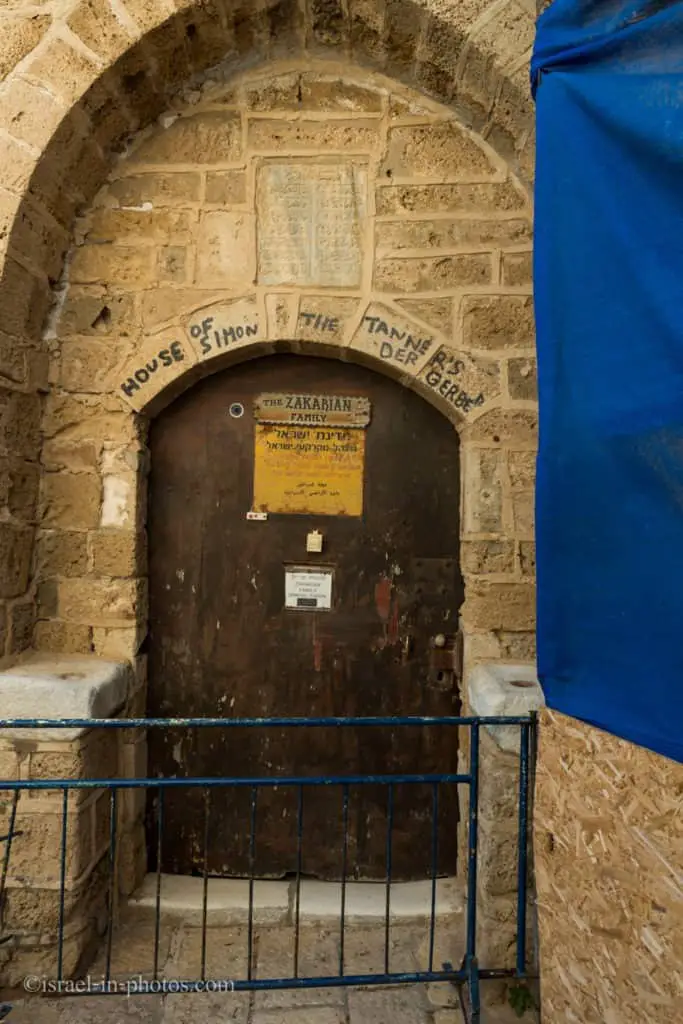
According to ancient Christian traditions, this structure is the home of Simon the Tanner, a site sacred to Christianity.
According to tradition, Simon the Tanner (leatherworker) hosted here Peter, Jesus’ Apostle, during his travels in the Land of Israel.
The New Testament says that Peter performed a miracle in Jaffa – the resurrection of Tabitha, a woman, known for her virtue, with the words “Tabitha, rise” (Acts 9). This miracle significantly increased the number of regional adherents to the newly-founded Christianity. Tabitha is still considered a saint representing charity and aid to others.
During his stay at the home of Simon, the Tanner, Peter dreamt a dream where he saw clean and unclean animals together. A heavenly voice told him to eat of the animals, and when he refused to eat unclean animals, the voice told him: “What God has made clean, do not call common.” Peter interpreted the dream as the divine sanction to spread Christianity not only among Jews but also among the pagan Romans, and he agreed to convert Cornelius, a Roman centurion in Caesarea. That marked a historical turning point in the process of transforming Christianity into a universal religion.
The house is owned by the Armenian Zakkarian family for several generations and is closed to visitors.
On the roof of the house, the British mandate constructed a lighthouse serving the ships entering the Jaffa Harbor. Near the lighthouse is a small mosque, Jama al Bodrus (Peter’s Mosque), constructed in 1730, as well as a guardhouse nearby meant to defend the city against attacks from the sea.
If you are interested in finding additional details about Tabitha, check out the Russian Orthodox Church In Abu Kabir.
Mysterious Room Of Adina Plastelina
On our way to the port:

Saint Peter’s Church from below:

After passing these spots and almost reaching sea level, you will see The Adina Plastelina gallery (23 Native Hamazalot Street). Here is a quote from their website:
In 2006, we performed extensive renovation work in the gallery. At that time, the ruins of an ancient limestone structure were revealed at the sand mound level. During a complex engineering effort, headed by Mr.Hassan El-Obidi, a round hollow with 280 cm, in diameter was uncovered.
What was this building used for? Was it for religious or use? Was it part of someone’s home or used for water storage? Who built it and during what period? Were they the ancient Egyptians, Phoenicians, Romans, or Crusaders?
The many and varied artifacts we discovered under the floor of the gallery, as well as within the remnants of this unique structure, serve as testimony to the lives and activities of residents—who have influenced the history of Jaffa for 3,500 years, spanning from the late-Bronze Age until today.
The Mysterious Room is an archeological site and private museum that showcases the assortment of artifacts we have found there, including seventeen coins from the Roman and Byzantine periods, arrowheads, a signed amphora handle from the Hellenistic period, a ballista ball, a Maltese cross, a collection of animal teeth, twenty Ottoman smoking pipes, and more.
The museum is an integral part of the Adina Plastelina gallery in Jaffa’s old city. We invite you to come and visit the museum and the gallery (free of charge).
The museum consists of one room and is suitable for a lovely shortstop.
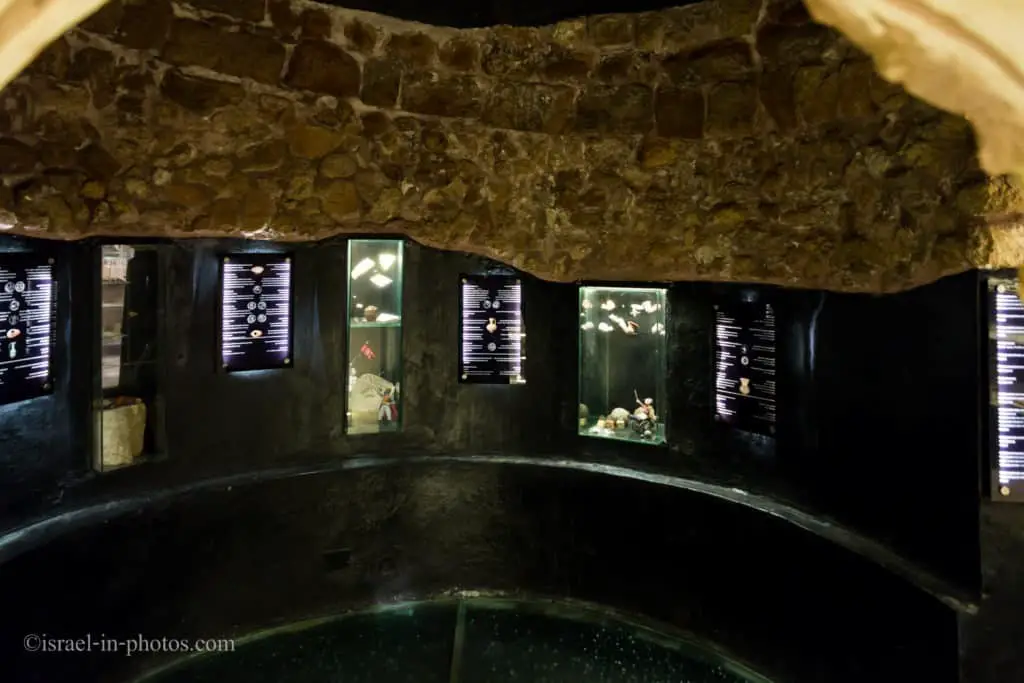
Jaffa Port
Jaffa Port is one of the most ancient ports in the world. And I have a dedicated guide where you can find all details about Jaffa Port.
Food in Jaffa
From the promenade, we went towards the Clock Tower. Not far from the Clock Tower, you can find Abulafia bakery (I wrote about it in Jaffa Flea Market). And we got this thing. Not sure there is a name, but it is round bread with a variety of toppings (20 NIS each).
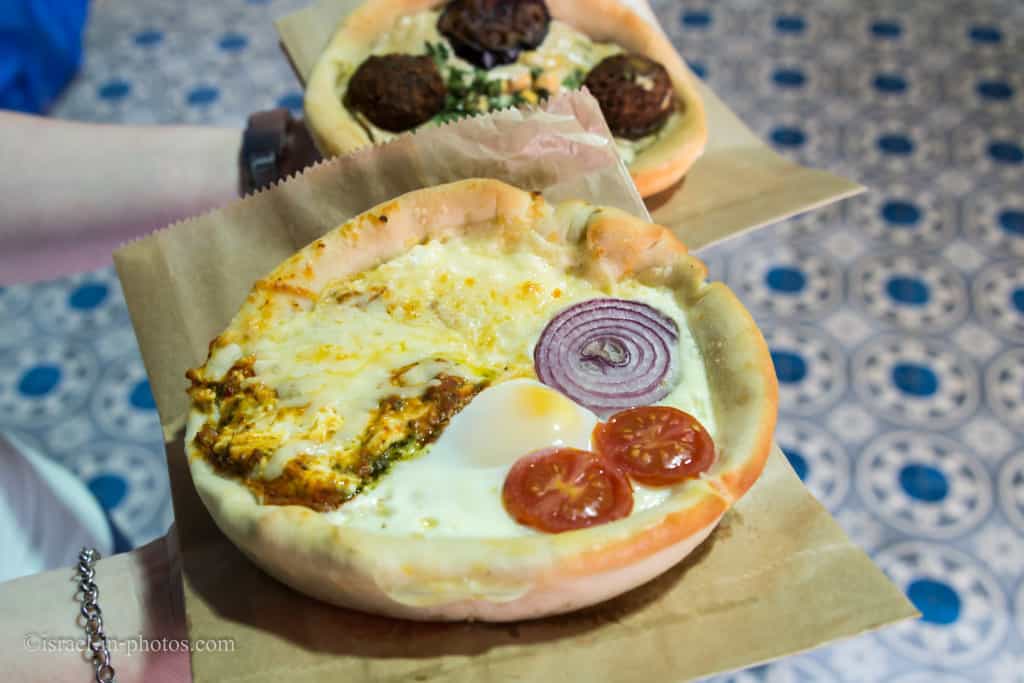
I have elaborated on food in Jaffa Flea Market. Check it out.
The Clock Tower
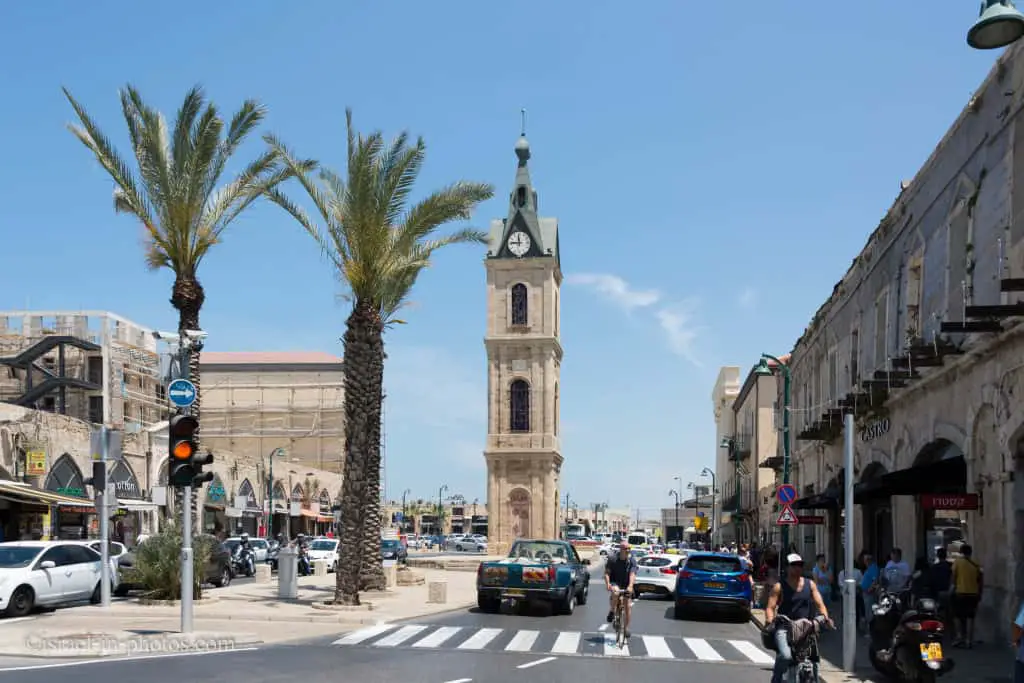
And no tour to Jaffa would be complete without The Clock Tower:
The clock tower was built in 1901 in the center of Jaffa’s town square.
The clock tower in Jaffa is one of seven clock towers built in Israel and of the hundred clock towers built in the Ottoman Empire in celebration of the 25th anniversary of the reign of the Turkish sultan Abdul Hamid the Second. The towers were made as part of the new reforms guided by the sultan, to conduct the empire’s cities by precise, Western timetables.
According to the local tale, the tower was built at the initiative of Yossef Moial, a wealthy Jew of Jaffa, who erected the clock tower to save himself pestering by pedestrians who would come into his shop to ask the time on their way to the train station.
Four clocks were installed in the tower – two of them showing the time in Europe, and two of them the time in Israel.
Restrooms
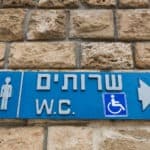
There are several public restrooms in this area. The easiest to find are: in front of Saint Peter’s Church and next to The Clock Tower (in a small alley to the east). To the right, in the photo of the clock tower above.
Along Yefet Street
So far, we have mostly covered Old Jaffa, but there are things to see further away. On another occasion, we continued along Yefet Street to the south. We saw Collège des Frères de Jaffa, a French international school, and the “Turret Building.”
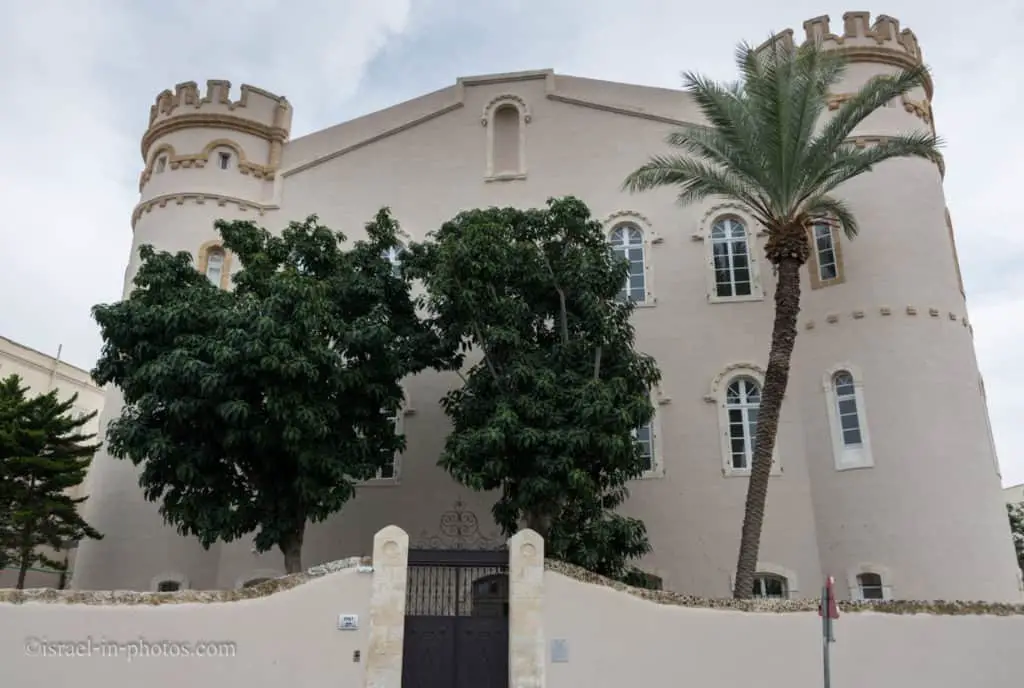
“Turret Building” is located on Yeffet 27. The building was designed for the Convent of the Sisters of Saint Joseph. The nuns built it after leaving the old city’s walls in 1883-1917. The original purpose of the building was a French-Catholic high school for girls. And today, the Turret Building serves as a hotel.
A reconstructed building:
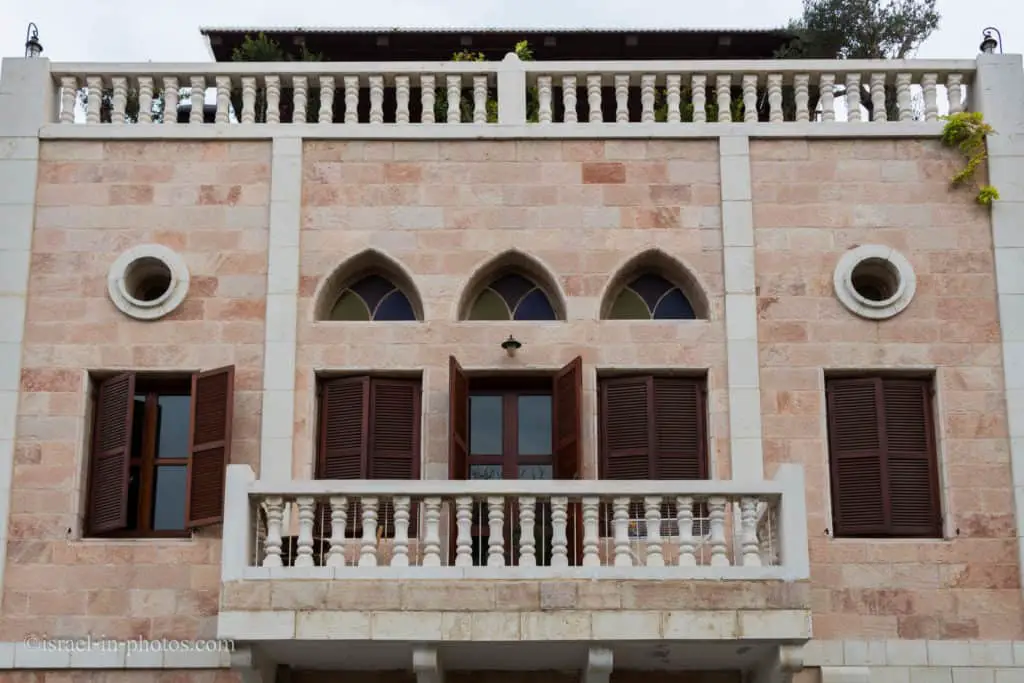
Further ahead on Yefet Street, you can find Saint Anthony’s Church.
Saint Anthony’s Church
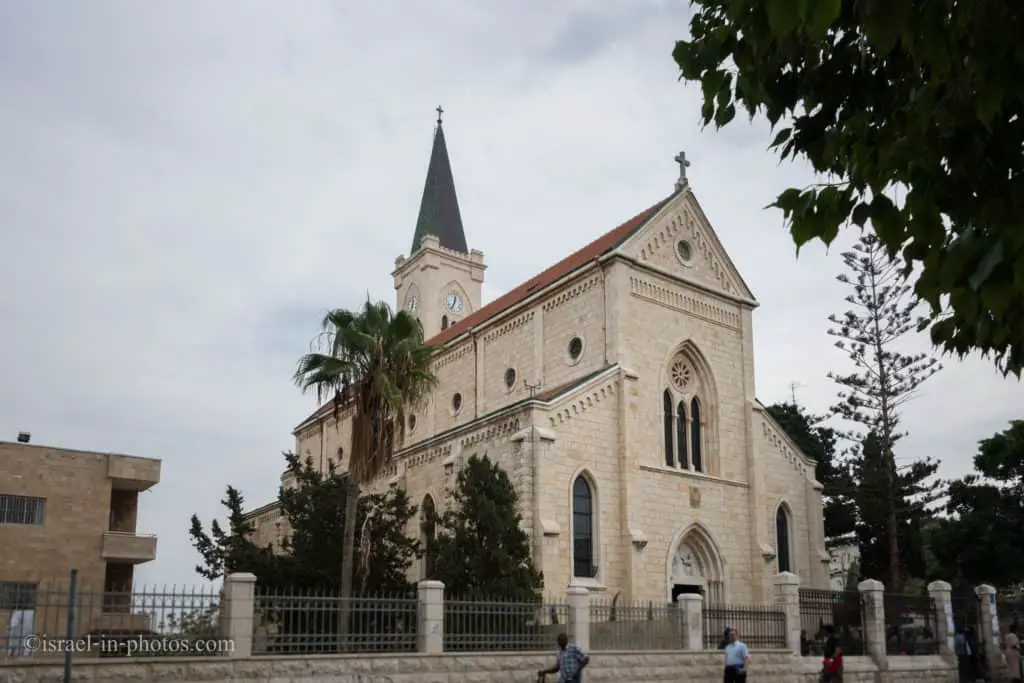
Saint Anthony of Padua Church, or simply Church of Saint Anthony, stands out for its Gothic Revival style and its clock tower. It was named in honor of Saint Anthony of Padua, a priest of the Franciscan Order, Portuguese preacher, and theologian venerated as a saint and Doctor of the Church by Catholicism.
The structure was completed in 1932. Foreign workers, mostly from the Philippines, used the church. On the north side of the church is the Terra Sancta high school run by nuns.
Religious services are offered in Arabic and English.
Source: Wikipedia
And just around the corner from Saint Anthony’s Church, there is the Church of Saint Anthony – to Roman Coptic.
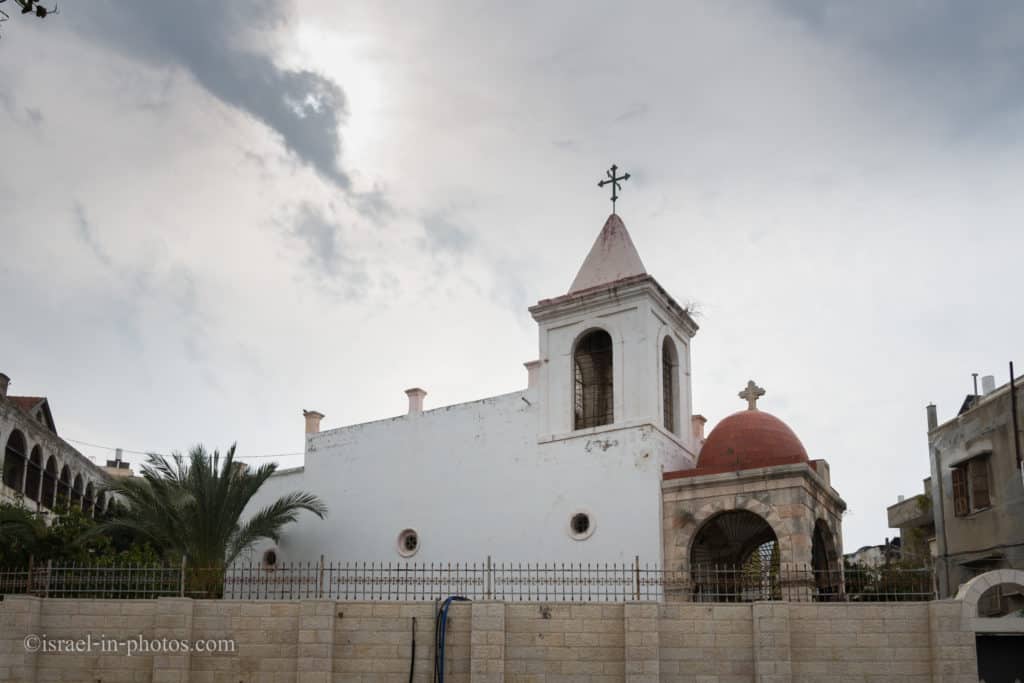
And this is Galei Tzahal. Galei Tzahal is a nationwide Israeli radio network operated by the Israel Defense Forces. And it is one of the most popular radio stations in Israel.
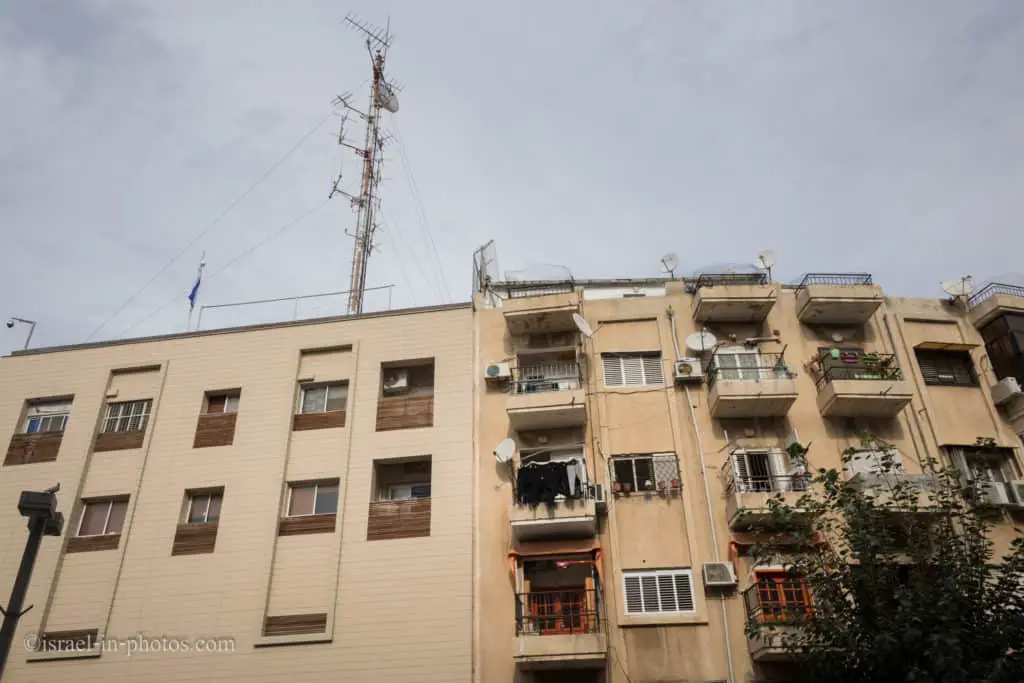
Common Questions
Where to Stay in Jaffa?
Inside Jaffa, there are no big buildings, thus no big hotels. You can stay at one of the boutique hotels nearby, or if you prefer a big hotel, you can stay in Tel Aviv (within walking distance). Moreover, you can find plenty of apartments for rent. Here is an already preset link to booking.com, where you can find the availability and prices of hotels and flats in this area.
Should I Join an Old Jaffa Tour?
As you can see, this post is quite long because there is a lot to cover. Numerous attractions, plenty of background information, and narrow old city alleys that can be difficult to navigate are reasons for joining a tour. The cons are the cost and the arrangement time. Thus, I would say that if you can, join a tour. Moreover, see the Bein Harim offer above.
Summary
Jaffa is one of the oldest port cities in the Mediterranean area. It is a beautiful place to wander around and enjoy the atmosphere. A typical visit will take 2 – 5 hours, but it will probably take the whole day if you want to visit all the mentioned places. In any case, you can either join a guided tour or explore the city by yourself.
Also, not far from the clock tower, you can find the Jaffa Flea Market (I visited it several times in the past and created a dedicated post).
Have you ever been to Jaffa? What is your favorite attraction? Tell us in the comments below.
That’s all for today, and I’ll see you in future travels!
Stay Tuned!
For additional attractions nearby, see Tel Aviv-Yafo.
Additional Resources
Here are several resources that I created to help travelers:- Trip Planner with Attractions and Itineraries is the page that will help you create your perfect travel route.
- What is the Best Time to visit Israel? To answer this question, we will consider the weather, prices, holidays, festivals, and more.
- Information and Tips for Tourists to Israel will answer the most common questions tourists have about Israel (including safety, passports, weather, currency, tipping, electricity, and much more).
- Israel National Parks and Nature Reserves include a complete list, top ten, map, tickets (Israel Pass, Matmon, combo), and campsites.
- If you are looking for things to do, here are the pages for Jerusalem, Tel Aviv, Haifa, Sea Of Galilee, Akko (Acre), Eilat, Nazareth, Safed (Tzfat), and Makhtesh Ramon.

